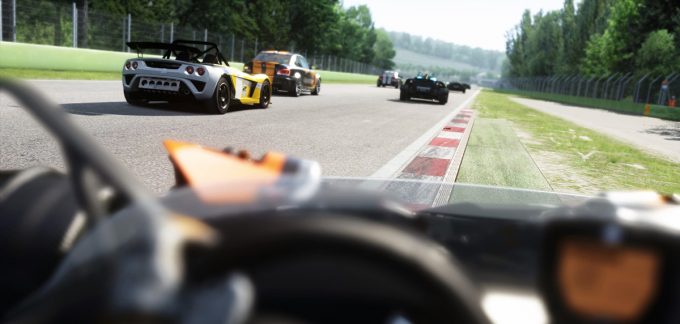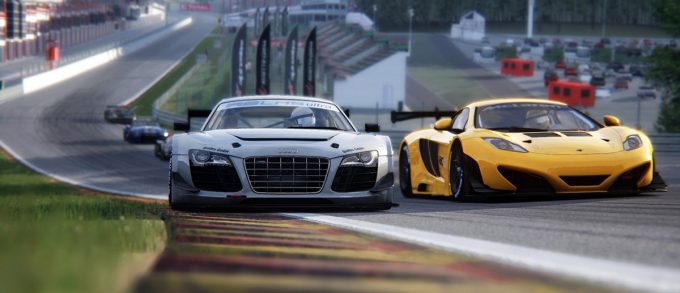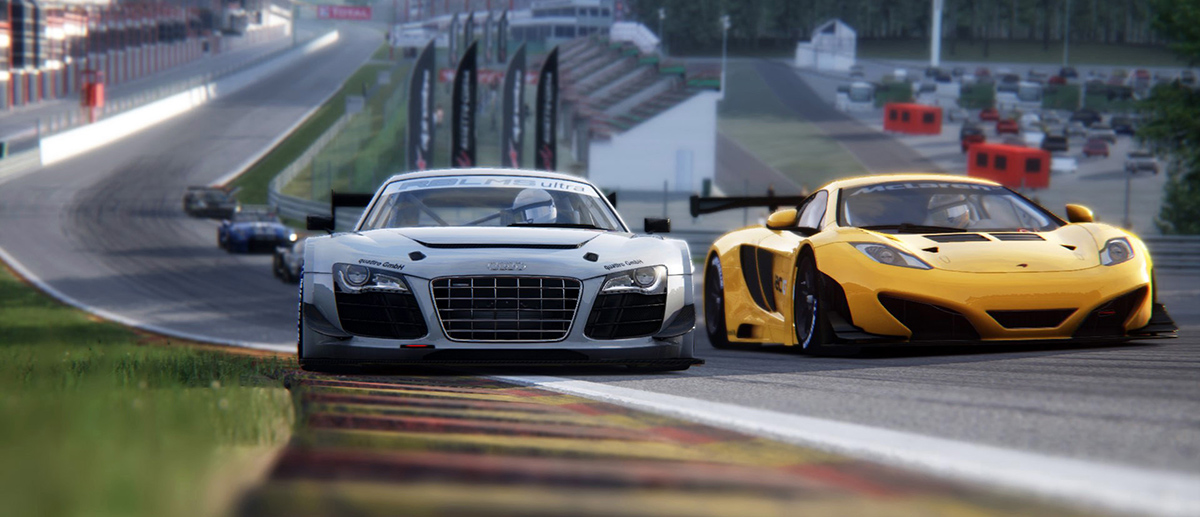
It’s so, so difficult to nail the realism of driving. In fact, there’s probably an uncanny valley when it comes to driving, much like there is to visuals. It can often be easy to pick apart a game’s attempts to mimic the act of moving on pavement, as truly understanding how a car is affected by the road requires metric tons of resources just to research. Developers often leap over this step, depending on the realism needs of their project, and thus many games with cars become “arcade-like.”
That’s not the case here with Assetto Corsa. In fact, it’s the most opposite possible. Not only does the game focus on realism, but it pushes it to levels on consoles which other heavyweights like Forza and Gran Turismo can’t even achieve yet. It is the purest driving simulator on any console, ever, and those who are driving fanatics will adore it. But where it hits all the points on being behind a wheel, it misses on some key areas that actually make it fun for those who aren’t.
Assetto Corsa on consoles is an adapted version of the game that appeared on PC a little over a year ago. The visuals aren’t as great as on something with a high end Nvidia, but they’re hardly mediocre. The cars are still stunning, and whether up close to one or from a pulled back camera, they hit a level of realism that makes us feel like they’re in our garages. Minute details like lighting accents and door handles or large ones like the surface quality of key quarterpanel sections breathe life into volume and the three-dimensionality of the vehicle forms. The car manufacturers and courses are Europe-heavy, but not exclusive. There isn’t a deep list, but what’s there is expertly detailed. I seem to always gravitate towards my Audi R8 dream car on the ‘Ring in racing games, but there are some gorgeous Ferraris and Lamborghinis (the Miura!) classic Lotus cars to make my mouth water. The environments leave much to the imagination — they aren’t as detailed or interesting as GT or Project Cars and certainly not as Forza — but at high speeds they zoom by so fast any ways that there isn’t really a need or desire to stop and stare. It also doesn’t help that the overall presentation focuses mainly on the race and not on the pre- and post-show. Things sort of pop around in pits or in preparation, and there isn’t a build-up to the beginning of a race. It doesn’t feel like it’s trying to excite me, but I don’t think that’s the point of the experience.
Visuals aren’t the only thing that make up the importance of modern racing games. In all reality, even subpar art direction can be forgiven if the driving is good. And boy is it good in Corsa. But it’s also very challenging.

Developers Kunos Simulazioni bill themselves as simulation experts, and that truth really shines with Corsa. They’ve focused their talents on making sure A) the controls are responsive and mapped to real world physics, and B) the vehicles are accurate in their driving uniqueness. The game’s controls are incredibly finely tuned, whether using a controller (like I did) or a wheel, to what feels like nano-levels of precision. No matter what vehicle I’m pushing, it genuinely feels like I’m behind the wheel, where the slightest movement is represented perfectly with my vehicle. The controls are tight, technical. Turns need to be planned for, not just approached. A good driver looks ahead, and Corsa demands us to be good drivers.
This really emphasizes how simulation-heavy the game is, and puts realism at the forefront. That means that no matter how fast or slow a car is that I’m driving, the entire experience of the race is because of my own skills. This is man and car, together, interacting and interfacing in a dance that we all do every day on roads around the world, albeit with a great big engine in front of or behind us. Am I a good driver? If so, then I can beat a Ferrari with a Fiat (with a little work). Online races against other (good) human opponents turn into jockeying for position and holding instead of ramming into everyone on a track and hitting the accelerator to the max at every opportunity. In fact, the best way to play the game is to drive steady and purposefully, maintaining corners and rarely hitting max speed. The best races end up being those where we’re in a huddle almost the entire way through, until one person makes a slight mistake and the rest can pull away.

It accomplishes incredibly accurate simulation on consoles, beyond even what Forza and Gran Turismo try to do.
But that also means that it’s not a game for everyone. Assetto Corsa is not so much a racing game as it is a driving experience. We need to already know and love cars, and probably be neurotic about the intricacies and intimacies of detailed suspensions and brake systems. We don’t play the game to race or expecting some mindblowing escape, we play to become one with the mechanics of our chosen car. And that can be frustrating if we’re not prepared. Even with selectable levels of difficulty, playing on Easy requires what feels like absolute perfection. We have to not only know our car, but also our track and our opponents, and anticipate all the opportunities that might arise as we zoom along. Easy level of play doesn’t seem to affect our car driving skills, just our opponents’, and minimally at that. That means that we still need to be expert drivers. It’s certainly not for the timid.
But though the simulation and vehicle side are damn near perfect, the rest of the game lacks that same finesse. There are three major modes in the game, but none are all that thrilling. The Career mode is very dry, relying on completion of a few tasks to achieve class certification before moving on to more powerful vehicles. These range from the (surprisingly enjoyable) Time Attack mode to repetitive races. Time Attack is satisfying, giving or taking away points based on how much time is left when we cross a checkpoint or if we run off of the track. Unfortunately the “driving perfect” aspect means that even if we just barely run off of the track against opponents in the racing tasks a race restart is almost always necessary. There’s no coming back from the slightest screw-up, and we have to race several times — sometimes dozens — before we finally achieve the minimum third place. There’s no incentive to go forward in the Career, either, since cars available to race with in the more open Special and Drive modes. That makes for an almost unnecessary addition of the mode, and one that feels like filler.

To use a racing metaphor, Assetto Corsa separates itself from its car game stablemates by focusing on the important interaction between man and machine, and the realism of how those two dance together, instead of the checkered flag goal. For a game about wheels, this doesn’t really feel like a quick race, but more of a 24 hour marathon. It’s not going to win the casual fan over, but with a definite strict simulation hole in modern console lineups, the obsessed “car guy” who owns racing chairs and expensive wheels and pedals will find this worthy of his or her time.
This review is based on a retail code sent to SideQuesting by the publisher for the Xbox One. The game was played through all modes and online.
Dali is an automotive designer by education and profession, and huge racing game enthusiast. He typically prefers a mix of simulation and arcade.
Members of the 505’s social media team have appeared on SideQuesting’s podcasts in the past prior to employment at the publisher.



1 Comment